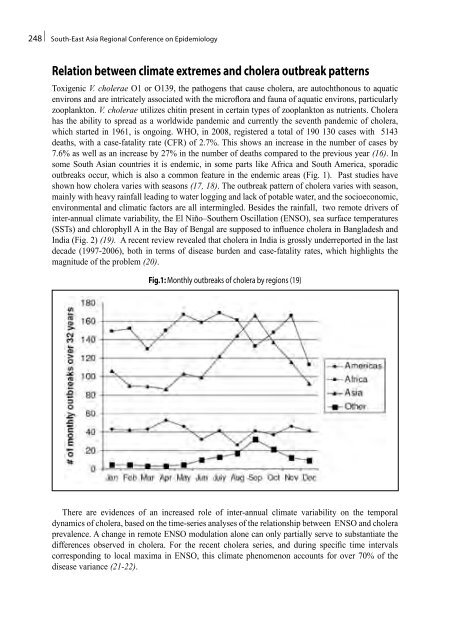South-East Asia Regional Conference on Epidemiology
South-East Asia Regional Conference on Epidemiology
South-East Asia Regional Conference on Epidemiology
You also want an ePaper? Increase the reach of your titles
YUMPU automatically turns print PDFs into web optimized ePapers that Google loves.
248 | <str<strong>on</strong>g>South</str<strong>on</strong>g>-<str<strong>on</strong>g>East</str<strong>on</strong>g> <str<strong>on</strong>g>Asia</str<strong>on</strong>g> <str<strong>on</strong>g>Regi<strong>on</strong>al</str<strong>on</strong>g> <str<strong>on</strong>g>C<strong>on</strong>ference</str<strong>on</strong>g> <strong>on</strong> <strong>Epidemiology</strong><br />
Relati<strong>on</strong> between climate extremes and cholera outbreak patterns<br />
Toxigenic V. cholerae O1 or O139, the pathogens that cause cholera, are autochth<strong>on</strong>ous to aquatic<br />
envir<strong>on</strong>s and are intricately associated with the microflora and fauna of aquatic envir<strong>on</strong>s, particularly<br />
zooplankt<strong>on</strong>. V. cholerae utilizes chitin present in certain types of zooplankt<strong>on</strong> as nutrients. Cholera<br />
has the ability to spread as a worldwide pandemic and currently the seventh pandemic of cholera,<br />
which started in 1961, is <strong>on</strong>going. WHO, in 2008, registered a total of 190 130 cases with 5143<br />
deaths, with a case-fatality rate (CFR) of 2.7%. This shows an increase in the number of cases by<br />
7.6% as well as an increase by 27% in the number of deaths compared to the previous year (16). In<br />
some <str<strong>on</strong>g>South</str<strong>on</strong>g> <str<strong>on</strong>g>Asia</str<strong>on</strong>g>n countries it is endemic, in some parts like Africa and <str<strong>on</strong>g>South</str<strong>on</strong>g> America, sporadic<br />
outbreaks occur, which is also a comm<strong>on</strong> feature in the endemic areas (Fig. 1). Past studies have<br />
shown how cholera varies with seas<strong>on</strong>s (17, 18). The outbreak pattern of cholera varies with seas<strong>on</strong>,<br />
mainly with heavy rainfall leading to water logging and lack of potable water, and the socioec<strong>on</strong>omic,<br />
envir<strong>on</strong>mental and climatic factors are all intermingled. Besides the rainfall, two remote drivers of<br />
inter-annual climate variability, the El Niño–<str<strong>on</strong>g>South</str<strong>on</strong>g>ern Oscillati<strong>on</strong> (ENSO), sea surface temperatures<br />
(SSTs) and chlorophyll A in the Bay of Bengal are supposed to influence cholera in Bangladesh and<br />
India (Fig. 2) (19). A recent review revealed that cholera in India is grossly underreported in the last<br />
decade (1997-2006), both in terms of disease burden and case-fatality rates, which highlights the<br />
magnitude of the problem (20).<br />
Fig.1: M<strong>on</strong>thly outbreaks of cholera by regi<strong>on</strong>s (19)<br />
There are evidences of an increased role of inter-annual climate variability <strong>on</strong> the temporal<br />
dynamics of cholera, based <strong>on</strong> the time-series analyses of the relati<strong>on</strong>ship between ENSO and cholera<br />
prevalence. A change in remote ENSO modulati<strong>on</strong> al<strong>on</strong>e can <strong>on</strong>ly partially serve to substantiate the<br />
differences observed in cholera. For the recent cholera series, and during specific time intervals<br />
corresp<strong>on</strong>ding to local maxima in ENSO, this climate phenomen<strong>on</strong> accounts for over 70% of the<br />
disease variance (21-22).









